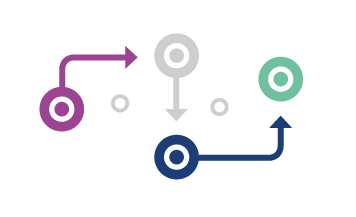What is the Hub?
A co-directed national partnership between Public Health Scotland, Police Scotland, and Edinburgh Futures Institute at the University of Edinburgh, that aims to take a whole-system public health approach focused on primary prevention, to support the reduction of health and wellbeing inequalities in Scotland. We’ll do this by bringing together research, policy, evidence and practice.
Together we aim to:
- Bring together data, evidence and insights to promote and deliver a collective approach
- Build a data collaboration
- Support and enable collaborative systems change work
- Embed learning and explore evaluation approaches for ‘whole systems change’ work
As well as being a hub of activity and ideas, we are also a physical hub, with our base at Edinburgh Futures Institute. This connects policing and public health practice, public health science, and academia. This is a move towards creating the conditions required for effective collaboration, challenging silo working across our organisations by efficiently galvanising our collective assets, skills, and resources.
Why are we coming together to do this work?
The health and wellbeing of the Scottish population is worsening. Most of Scotland’s Local Authority areas have seen a fall in life expectancy since 2017, and people are spending more of their lives in poor health with healthy life expectancy decreasing since 2014/15. Inequalities in health and wellbeing outcomes across the life course are also worsening.
There are clear links between health and justice: some determinants of health, for example, adverse childhood experiences, poverty, social exclusion, and addiction, also increase the likelihood of becoming involved in the criminal justice system. No sector alone is capable of addressing the complex range of issues facing our populations’ health and wellbeing. The widening inequalities in health and justice are preventable, but require collaborative leadership and working within a public health approach, including an active commitment to prevention, making use of evidence, evaluation and assessment of impact.
Our public sector is fragmented, with questions over public service sustainability because of increasing demand, low morale, scrutiny, digital and technological advances, and tightening public sector finances. The recommendations of the Christie Commission report on the Future Delivery of Public Services (2011) remain relevant more than a decade after publication, and are essential to break the vicious churn of resource being used on siloed efforts to tackle problems downstream. The report highlighted the need for empowerment, integration, prevention and efficiency, and this has fed into the development of the Scottish Prevention Hub.
Collaboration is complex; we need to pay attention to collaborative leadership in practice and building the capability and capacity for the work. Single organisations do not have all the answers, as generational harm cannot be undone easily; wider partner involvement is essential. Barriers need to be broken down in terms of ways of working, including around data sharing and joint planning, in order to deliver more integrated up services to citizens and ultimately improve outcomes in an equitable way.
“We’re delighted to partner with Police Scotland and the Futures Institute. This collaboration aims to empower local areas to address public health concerns, improve mental wellbeing and support those facing the challenges of poverty to name a few. By working together, we are taking a further step towards reducing inequalities and improving health and wellbeing for a Scotland where everybody thrives.”
Diane Stockton, Prevention Hub Lead at Public Health Scotland
Our key workstreams
Data
Collaboration
Build a common data platform, near-real time linked data to inform operations, policy and research.
Research
& Evidence
Enable challenge-led, co-designed research, and what works.
Place Based
Insights
Coordination and connection of national and local organisations to maximise impact.
Collaborative
Leadership
Build capacity and capability for complex work.
Learning
& Evaluation
Embed learning, whole systems evaluation, working out loud.
Sustainable
Structures
Work differently – processes, relationships, sharing risk and resources.
Our underpinning methodology
Multisectoral collaboration and system change is challenging and complex; working with others and creating the right conditions for effective collaboration is difficult. However, we know we must pay more attention to this for better results and improved outcomes. Challenges include inflexible structures and silos; power imbalances; leadership tensions; technology and data security; how to evaluate and measure progress; and conflicting interests, motivations, and approaches. Our underpinning methodology for effective collaboration essentially requires working differently.
We are applying this framework for collaboration –
our 4 principle approach:

System Focused
The concept or the idea of taking a systems- focused approach is to think about our organisations as a collection of parts that function as a whole, this is needed in order to respond to shared and complex issues.
Emergent
Working in an emergent way can be really helpful – although not easy – This approach generates a new way of working, often used when other planned approaches or ‘solutions’ have not worked.
Working emergently is sometimes explained as an unstructured method. Importantly it gives space and time, and allows for the unpacking of issues that are problematic and get in the way of collaborative work.
Relational
Taking a conscious step towards getting to know people and their work, and privileging relational matters above or equal to a task, can adjust typical communication and behavioural patterns. It is through these exchanges that diverse viewpoints are more comfortably shared, as members relate together, shaping a new course of action.
Inquiry led
Beginning an inquiry into the group process, the issue or problem, seeks to merge the subjective (what do I think) with the intersubjective (what do we think) and the objective data (what has been done already and what was the result), in order to enrich self-awareness, fresh learning, and shape a different way of working.
We aim to build capacity and capability for complex work by offering multi-agency leadership learning. We will explore and share our experience of collaborative leadership in action and build momentum for further support and learning linked to growing capacity for complex collaborative work.
Latest thinking and updates
Our wider team and network of researchers and partners
- Susan McVie,
Professor of Quantitative Criminology, Edinburgh Law School - Steve Earl
Portfolio Manager, Edinburgh Futures Institute - Andrew Williams
Senior Lecturer and Co-Director for Scottish Collaboration for Public Health Research and Policy, School of Health in Social Science
- Ruth Jepson
Professor of Public Health in Social Science | Director of Scottish Collaboration for Public Health Research and Policy, School of Health in Social Science - Linda Bauld
Bruce and John Usher Professor of Public Health | Co-Head of Centre for Population Health Sciences - Lesley McAra
IASH Director
















